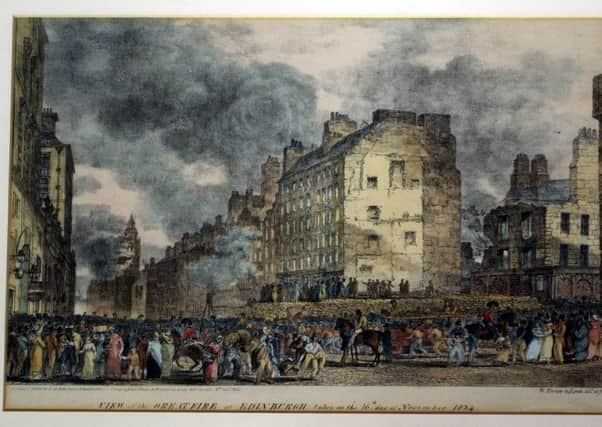On this day 1824: Edinburgh's Great Fire broke out


The fire was to rage over two days and take another two to fully extinguish. Some 400 homes around the High Street were destroyed with 13 people killed, two of them firemen, as fire moved across three main sites.
Extreme damage was inflicted to Tron Church and Parliament Square with large swathes of tenement falling to the ground.
Advertisement
Hide AdAdvertisement
Hide AdCrowds hurried to witness the spectacle after the fire broke out in the second flat of a house at the head of the Old Assembly Close, occupied by Messrs. Kirkwood and Sons, copper-plate printers.
Ten or perhaps 11 fire engines arrived on the spot with soldiers dispatched to the scene from the castle. The Sheriff, Lord Provost and the city Bailies, also attended along with “many other high official personages.”
By midnight “one stupendous blaze” had taken over three tenements between Borthwick’s Close and the tenement at Old Assembly Close, according to Robert Chambers in his pamphlet “Notices of the Most Remarkable Fires in Edinburgh: From 1385 to 1824”, which was swiftly updated following the November 15 blaze.
Chambers said: “While the three front tenements were yielding to destruction, the night was calm and serene, and the sparks send forth by the flames rose high into the air, like embers shot from the crater of a volcano.”
Overnight, the wind picked up, fanning the fires in the High Street. The Courant Office collapsed with an adjoining house in Old Fishmarket close, occupied by Abraham Thomson, a book binder, crushed by falling masonry. The Old Assembly Hall, then a warehouse for a bookseller, was also destroyed.
By 9am, the fire had considerably abated but the calm was short lived.
Chambers said: “The fears of all were revived by the appearance of another sudden and unexpected calamity in a different quarter.
Advertisement
Hide AdAdvertisement
Hide Ad“A little before twelve o’clock, the word was given that the Tron Church was on fire!
“The agitation and alarm communicated to every part of the town by this intelligence, it is impossible to describe.”
It was supposed that some of the flying embers had found there way into the tower and had been “fanned into a flame” by the wind to “produce the dreadful catastrophe.”
In a short time, the whole “superstructure” of the steeple, made entirely of wood and cased in lead, was ablaze.
The weathercock began to veer - as did the spire -towards the east with both falling to the ground with a “tremendous crash” with spectators whispering of the “judgement-like” spectacle before them.
The devastation did not stop there, however, and by 10pm a third outbreak of fire had been declared at Parliament Square.
The fire “speedily” progressed from the chambers of Mr Guthrie Wright, auditor of the Court of Session, to the Jury-Court Room and down to the depths of the building below.
Advertisement
Hide AdAdvertisement
Hide AdFurniture and loose papers were thrown from the windows as the flames took hold with firefighters working to stop the spread to St Giles’ Cathedral and Parliament Hall.
The district was “threatened with impending ruin,” Chambers said.
He added: “About five o’clock in the morning, all the eastern side of the Square, not consumed by the recent fire of June last, presented one huge burning tower, the beams crashing and falling inwards, and every opening and window pouring forth flame.
“The scene was now awfully grand....the whole horizon was completely enveloped in lurid flame.”
Chamber later described scenes of “liquid fire” with the clattering of horse’s hoofs adding a “kind of martial terror to the scene.”
The city’s fire brigade, recognised as the world’s first official municipal fire service, had only recently been formed by 24-year-old pioneer James Braidwood.
The firefighters had not yet received full training and struggled against the relentless blaze but a subsequent inquiry found that firemen had been given contradictory orders by city leaders.
Advertisement
Hide AdAdvertisement
Hide AdAs a result of the inquiry, firemasters were given full command of firefighting incidents - a power structure which exists to this day.
Braidwood’s legacy was suitably recognised by the city of Edinburgh in 2008 when a statue on Parliament Square was put in place - on the spot where his men had worked to protect St Giles’ from the blaze.
